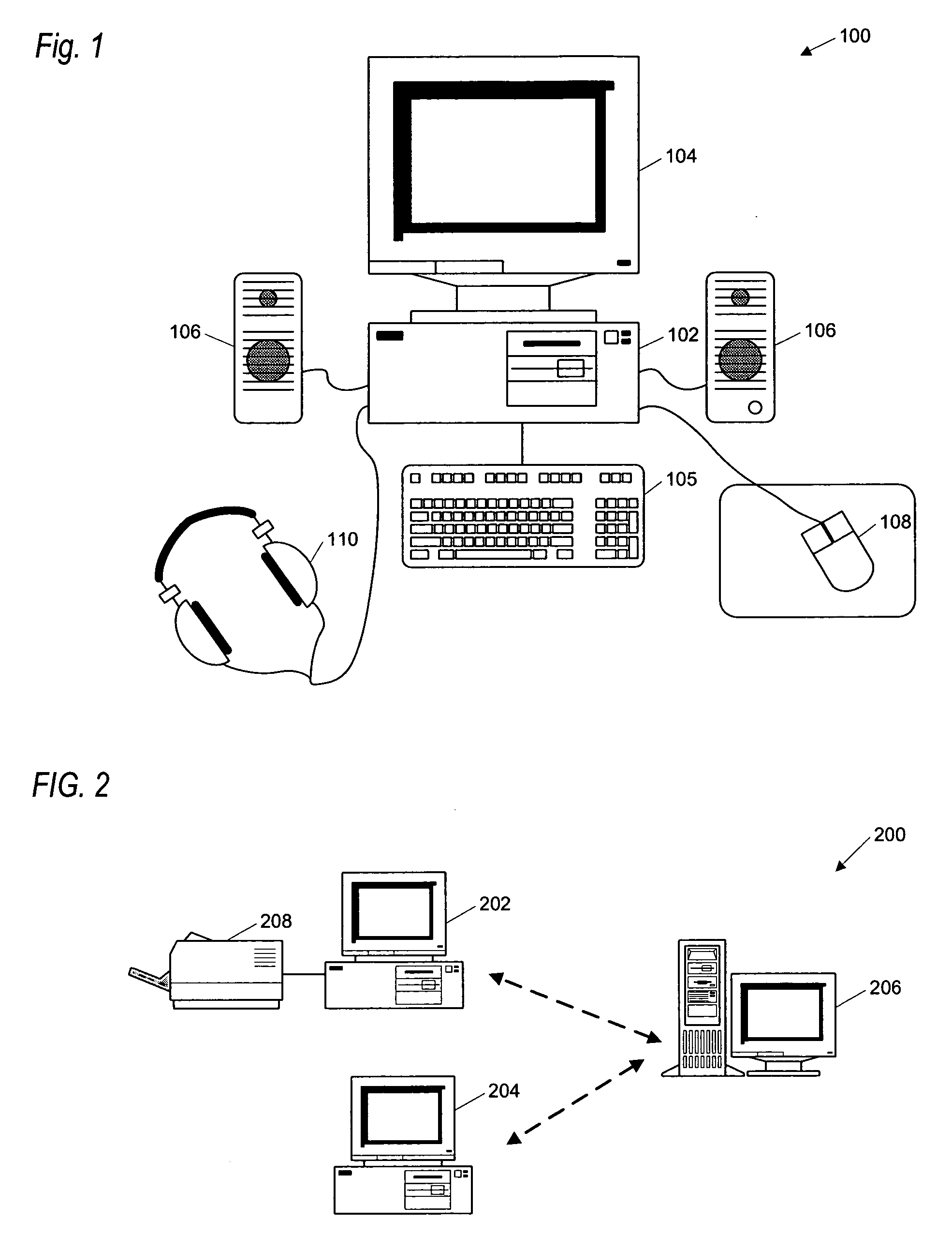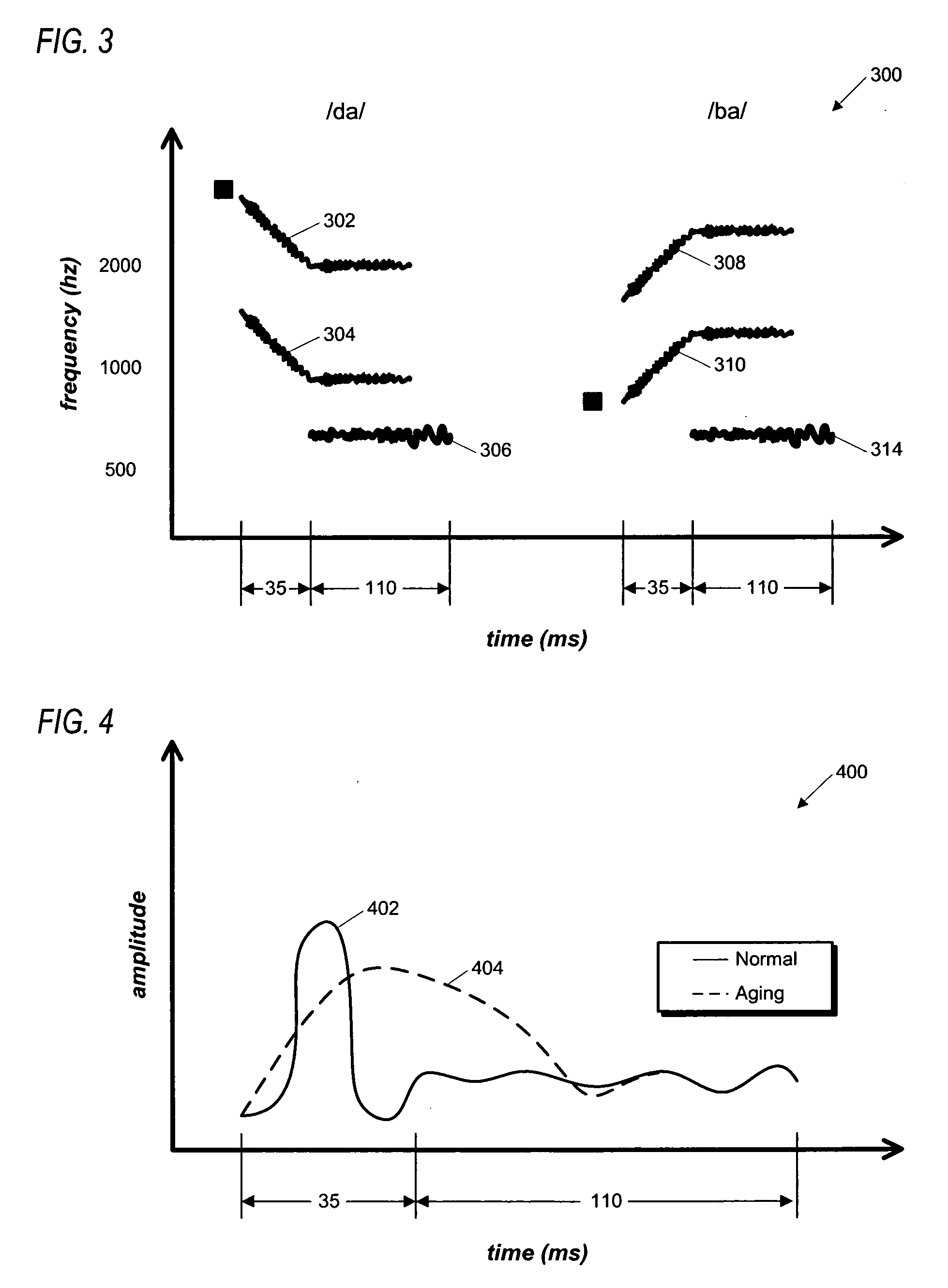[0015] The
training program described below is designed to: Significantly improve “noisy” sensory representations by improving representational fidelity and
processing speed in the auditory and visual systems. The stimuli and tasks are designed to gradually and significantly shorten time constants and space constants governing temporal and spectral / spatial
processing to create more efficient (accurate, at speed) and powerful (in terms of distributed response coherence) sensory reception. The overall effect of this improvement will be to significantly enhance the salience and accuracy of the auditory representation of speech stimuli under real-world conditions of rapid temporal modulation, limited stimulus discriminability, and significant
background noise.
[0016] In addition, the
training program is designed to significantly improve neuromodulatory function by heavily engaging attention and reward systems. The stimuli and tasks are designed to strongly, frequently, and repetitively activate attentional, novelty, and reward pathways in the brain and, in doing so, drive endogenous activity-based systems to sustain the health of such pathways. The goal of this rejuvenation is to re-engage and re-differentiate 1)
nucleus basalis control to renormalize the circumstances and timing of ACh release, 2) ventral tegmental, putamen, and nigral DA control to renormalize DA function, and 3) locus coeruleus,
nucleus accumbens, basolateral amygdale and mammillary body control to renormalize NE and integrated limbic
system function. The result re-enables effective learning and memory by the brain, and to improve the trained subjects' focused and sustained attentional abilities,
mood, certainty, self confidence, motivation, and attention.
[0018] The present invention provides a method on a computing device for exposing an
auditory system of an aging adult to a plurality of syllables, which requires the adult to temporarily store and retrieve an order of the syllables, the syllables processed to emphasize and stretch rapid frequency transitions. The method includes: providing a plurality of syllables for presentation to the adult, on the computing device; providing a plurality of processing levels for processing the syllables for presentation on the computing device; selecting from the plurality of processing levels, a first processing level to be used to process selected syllables; selecting from the plurality of syllables, a first plurality of syllables for presentation, both aurally and graphically, on the computing device; aurally presenting on the computing device the first plurality of syllables according to the first processing level, the first plurality of syllables presented serially; after the step of aurally presenting, graphically presenting on the computing device the first plurality of syllables; requiring the adult to select on the computing device the graphically presented syllables corresponding to an order in which they were aurally presented; and repeating the steps of selecting from the plurality of syllables, aurally presenting, graphically presenting, and requiring; wherein the step of repeating results in exposing the
auditory system of the aging adult to a substantial number of processed syllables thereby driving improvements in the adult's
working memory.
[0019] In another aspect, the present invention provides a method on a computing device for improving
working memory in an aging adult, the method requiring the adult to remember and use computer processed
syllable information in auditory
working memory, the method including: providing on the computing device, a plurality of syllables for presentation to the adult; providing on the computing device, a plurality of processing levels for processing the syllables for presentation; selecting from the plurality of processing levels, a first processing level to be used to process selected syllables; selecting from the plurality of syllables, a first plurality of syllables for presentation, both aurally and graphically, on the computing device; aurally presenting on the computing device the first plurality of syllables according to the first processing level, the first plurality of syllables presented serially; after the step of aurally presenting, graphically presenting on the computing device the first plurality of syllables; requiring the adult to select on the computing device the graphically presented syllables corresponding to an order in which they were aurally presented; and repeating the steps of selecting from the plurality of syllables, aurally presenting, graphically presenting, and requiring; wherein the step of repeating results in exposing the
auditory system of the aging adult to a substantial number of processed syllables thereby improving the adult's working memory.
[0021] In a further aspect, the present invention provides a method for improving the working memory in an aging adult, the method presented on a computing device, the method including: aurally presenting on the computing device two
consonant-
vowel-
consonant (CVC) syllables, the syllables processed to separate the
consonant portions and the
vowel portion of the syllables by a predetermined time period, the syllables presented one after the other; graphically presenting on the computing device, the two aurally presented syllables, the graphically presented syllables selectable by the adult; requiring the adult to select the graphically presented syllables in the order in which they were aurally presented; if the adult correctly selects the graphically presented syllables in the order in which they were aurally presented, increasing the number of syllables presented to the adult, and repeating the steps of aurally presenting, graphically presenting, and requiring; wherein the working memory of the aging adult is improved by repeating the steps of aurally presenting thru repeating.
 Login to View More
Login to View More  Login to View More
Login to View More 


